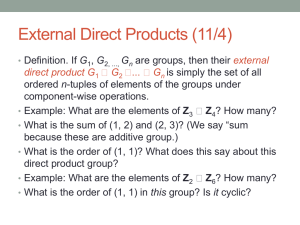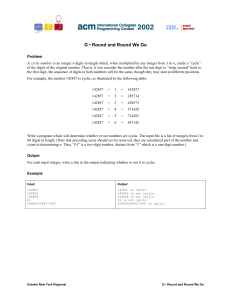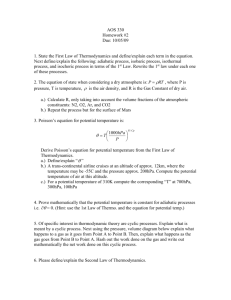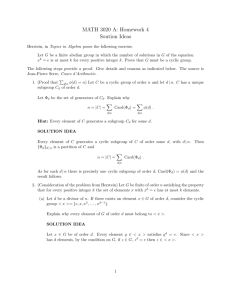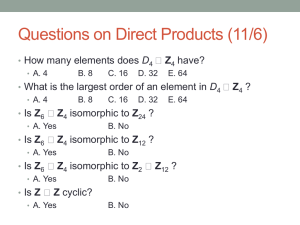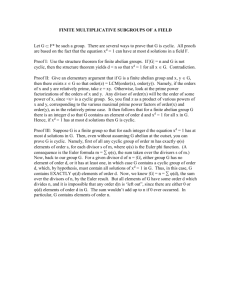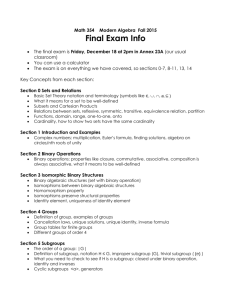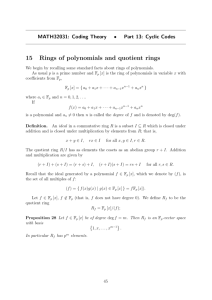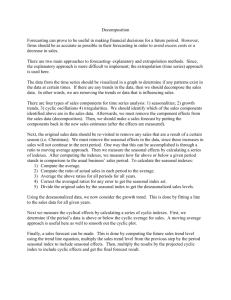3.5 Cyclic Groups
advertisement
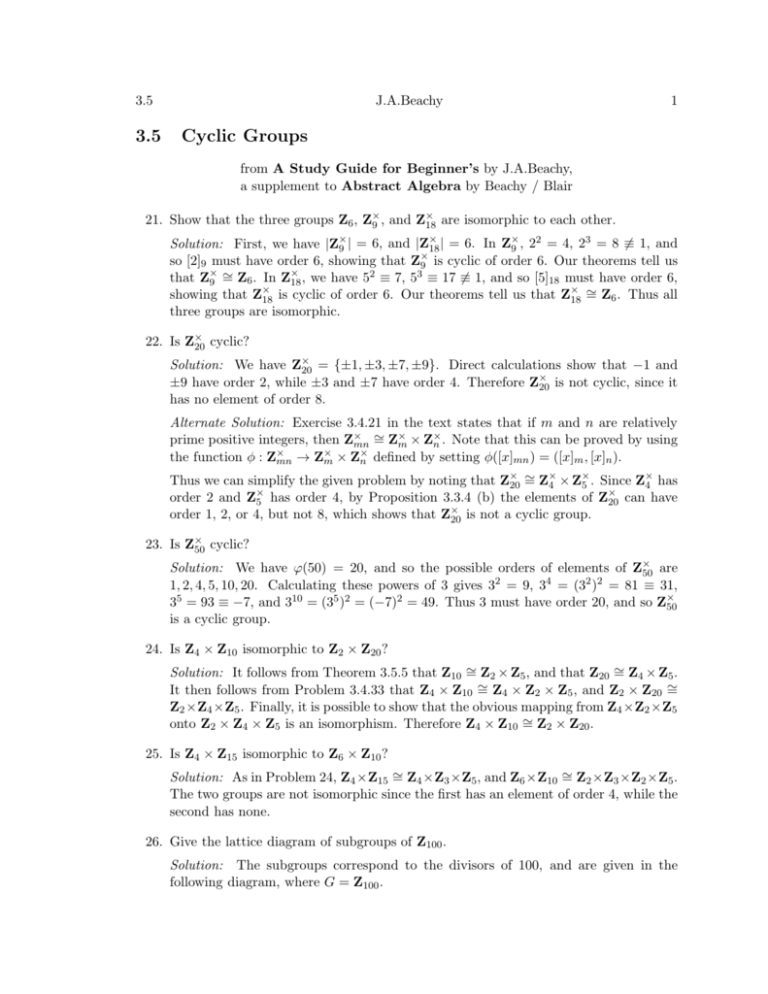
3.5
3.5
J.A.Beachy
1
Cyclic Groups
from A Study Guide for Beginner’s by J.A.Beachy,
a supplement to Abstract Algebra by Beachy / Blair
×
21. Show that the three groups Z6 , Z×
9 , and Z18 are isomorphic to each other.
×
×
2
3
Solution: First, we have |Z×
9 | = 6, and |Z18 | = 6. In Z9 , 2 = 4, 2 = 8 6≡ 1, and
×
so [2]9 must have order 6, showing that Z9 is cyclic of order 6. Our theorems tell us
×
2
3
∼
that Z×
9 = Z6 . In Z18 , we have 5 ≡ 7, 5 ≡ 17 6≡ 1, and so [5]18 must have order 6,
×
∼
showing that Z18 is cyclic of order 6. Our theorems tell us that Z×
18 = Z6 . Thus all
three groups are isomorphic.
22. Is Z×
20 cyclic?
Solution: We have Z×
20 = {±1, ±3, ±7, ±9}. Direct calculations show that −1 and
±9 have order 2, while ±3 and ±7 have order 4. Therefore Z×
20 is not cyclic, since it
has no element of order 8.
Alternate Solution: Exercise 3.4.21 in the text states that if m and n are relatively
×
∼ ×
prime positive integers, then Z×
mn = Zm × Zn . Note that this can be proved by using
×
×
×
the function φ : Zmn → Zm × Zn defined by setting φ([x]mn ) = ([x]m , [x]n ).
Thus we can simplify the given problem by noting that Z× ∼
= Z× × Z× . Since Z× has
20
4
5
4
×
order 2 and Z×
5 has order 4, by Proposition 3.3.4 (b) the elements of Z20 can have
order 1, 2, or 4, but not 8, which shows that Z×
20 is not a cyclic group.
23. Is Z×
50 cyclic?
Solution: We have ϕ(50) = 20, and so the possible orders of elements of Z×
50 are
1, 2, 4, 5, 10, 20. Calculating these powers of 3 gives 32 = 9, 34 = (32 )2 = 81 ≡ 31,
35 = 93 ≡ −7, and 310 = (35 )2 = (−7)2 = 49. Thus 3 must have order 20, and so Z×
50
is a cyclic group.
24. Is Z4 × Z10 isomorphic to Z2 × Z20 ?
Solution: It follows from Theorem 3.5.5 that Z10 ∼
= Z2 × Z5 , and that Z20 ∼
= Z4 × Z5 .
∼
It then follows from Problem 3.4.33 that Z4 × Z10 = Z4 × Z2 × Z5 , and Z2 × Z20 ∼
=
Z2 ×Z4 ×Z5 . Finally, it is possible to show that the obvious mapping from Z4 ×Z2 ×Z5
onto Z2 × Z4 × Z5 is an isomorphism. Therefore Z4 × Z10 ∼
= Z2 × Z20 .
25. Is Z4 × Z15 isomorphic to Z6 × Z10 ?
∼ Z4 ×Z3 ×Z5 , and Z6 ×Z10 ∼
Solution: As in Problem 24, Z4 ×Z15 =
= Z2 ×Z3 ×Z2 ×Z5 .
The two groups are not isomorphic since the first has an element of order 4, while the
second has none.
26. Give the lattice diagram of subgroups of Z100 .
Solution: The subgroups correspond to the divisors of 100, and are given in the
following diagram, where G = Z100 .
3.5
J.A.Beachy
G
@
h2i
h5i
@
h4i
2
@
h10i
h25i
@
@
h20i
h50i
@
h0i
Here hni is the set of all multiples of [n]100 in Z100 .
27. Find all generators of the cyclic group Z28 .
Solution: By Corollary 3.5.4 (a), the generators correspond to the numbers less than
28 and relatively prime to 28. The Euler ϕ-function allows us to compute how many
there are: ϕ(28) = 21 · 67 ·28 = 12. The list of generators is {±1, ±3, ±5, ±9, ±11, ±13}.
28. In Z30 , find the order of the subgroup h18i; find the order of h24i.
Solution: Using Proposition 3.5.3, we first find gcd(18, 30) = 6. Then h18i = h6i, and
so the subgroup has 30/6 = 5 elements.
Similarly, h24i = h6i, and so we actually have h24i = h18i, and | h24i | = 5.
29. In Z45 find all elements of order 15.
45
= 3, it follows that [3] has order 15, and that | h3i | = 15. If [a] is
Solution: Since 15
another elements of order 15, then gcd(a, 45) = 3 by Proposition 3.5.3, and [a] ∈ h[3]i.
The easiest way to find these elements is to remember that h[3]i is cyclic of order 15
and therefore isomorphic to Z15 . The generators of Z15 correspond to the integers
1, 2, 4, 7, 8, 11, 13, 14 that are relatively prime to 15, and so the elements of order 15
in Z45 correspond to these multiples of 3. Answer: the elements of order 15 in Z45
are [3], [6], [12], [21], [24], [33], [39], [42].
30. Prove that if G1 and G2 are groups of order 7 and 11, respectively, then the direct
product G1 × G2 is a cyclic group.
Solution: Since 7 and 11 are primes, the groups are cyclic. If a has order 7 in G1 and
b has order 11 in G2 , then (a, b) has order lcm[7, 11] = 77 in G1 × G2 . Thus G1 × G2
is cyclic since it has an element whose order is equal to the order of the group.
31. Show that any cyclic group of even order has exactly one element of order 2.
Solution: If G is cyclic of order 2n, for some positive integer n, then it follows from
Theorem 3.5.2 that G is isomorphic to Z2n . Since isomorphisms preserve orders of
elements, we only need to answer the question in Z2n . In that group, the elements of
order 2 are the nonzero solutions to the congruence 2x ≡ 0 (mod 2n), and since the
congruence can be rewritten as x ≡ 0 (mod n), we see that [n]2n is the only element
of order 2 in Z2n .
3.5
J.A.Beachy
3
×
32. Use the the result in Problem 31 to show that the multiplicative groups Z×
15 and Z21
are not cyclic groups.
Solution: In Z×
15 , both [−1]15 and [4]15 are easily checked to have order 2.
2
In Z×
21 , we have [8]21 = [64]21 = [1]21 , and so [8]21 and [−1]21 have order 2.
33. Prove that if p and q are different odd primes, then Z×
pq is not a cyclic group.
Solution: We know that [−1]pq has order 2, so by Problem 31 it is enough to find one
other element of order 2. The Chinese remainder theorem (Theorem 1.3.6) states that
the system of congruences x ≡ 1 (mod p) and x ≡ −1 (mod q) has a solution [a]pq ,
since p and q are relatively prime. Because p is an odd prime, [−1]pq is not a solution,
so [a]pq 6= [−1]pq . But a2 ≡ 1 (mod p) and a2 ≡ 1 (mod q), so a2 ≡ 1 (mod pq) since
p and q are relatively prime. Thus [a]pq has order 2.
34. Find all cyclic subgroups of the quaternion group. Use this information to show
that the quaternion group cannot be isomorphic to the subgroup of S4 generated by
(1, 2, 3, 4) and (1, 3).
Solution: The quaternion group Q = {±1, ±i, ±j, ±k} is defined in Section 3.3. The
elements satisfy the following identities:
i2 = j2 = k2 = −1 and ij = k, jk = i, ki = j, ji = −k, kj = −i, ik = −j.
The cyclic subgroups h−1i = {±1}, h±ii = {±1, ±i}, h±ji = {±1, ±j}, and h±ki =
{±1, ±k} can be found by using the given identities. For example, i2 = −1, i3 = i2 i =
−i, and i4 = i2 i2 = (−1)2 = 1.
In S4 , let (1, 2, 3, 4) = a and (1, 3) = b. Since a is a cycle of length 4, it has order 4,
with a2 = (1, 3)(2, 4) and a3 = a−1 = (1, 4, 3, 2). To find the subgroup generated by a
and b, we have ab = (1, 2, 3, 4)(1, 3) = (1, 4)(2, 3), a2 b = (1, 3)(2, 4)(1, 3) = (2, 4), and
a3 b = (1, 4, 3, 2)(1, 3) = (1, 2)(3, 4). On the other side, we have ba = (1, 3)(1, 2, 3, 4) =
(1, 2)(3, 4) = a3 b, ba2 = (1, 3)(1, 3)(2, 4) = (2, 4) = a2 b, and ba3 = (1, 3)(1, 4, 3, 2) =
(1, 4)(2, 3) = ab. This shows that the subgroup generated by a and b consists of the
8 elements {e, a, a2 , a3 , b, ab, a2 b, a3 b}. Furthermore, from the cycle structures of the
elements we can see that the only cyclic subgroup of order 4 is the one generated by a
(and a3 ). In any isomorphism, cyclic subgroups would correspond to cyclic subgroups,
and so it is impossible for this group to be isomorphic to the quaternion group, which
has 3 cyclic subgroups of order 4.
ANSWERS AND HINTS
35. Let G be a cyclic group of order 25, written multiplicatively, with G = hai. Find all
elements of G that have order 5.
Answer: The elements a5 , a10 , a15 , a20 have order 5.
36. Let G be a group with an element a ∈ G with o(a) = 18. Find all subgroups of hai.
3.5
J.A.Beachy
4
hai
@
2
a
@
a6
a3
@
@
a9
{e}
38. Give an example of an infinite group in which every element has finite order.
Answer: One possibility it to let G be the subgroup of elements of finite order in C× ,
the set of all nth roots of unity, for all n > 0.
1 a b
43. Let D =
0 1 c a, b, c ∈ Z2 . Note that D is a group by Problem 3.3.44.
0 0 1 (a) Find the number of elements of order 4 in D. Use this and the fact that D is
nonabelian to guess which of the groups O, P , or Q (from Section 3.1) might be
isomorphic to D.
Answer: Since D has 2 elements of order 4, the only possibility is that D might be
isomorphic to P , and this turns out to be true.
44. Let n be a positive integer which has the prime decomposition n = pα1 1 pα2 2 · · · pαmm ,
×
×
∼ ×
where p1 < p2 < . . . < pm . Prove that Z×
m.
n = Zpα1 × Zpα2 × · · · × Zpα
m
2
1
Hint: Exercise 3.4.21 states that if m and n are relatively prime positive integers, then
×
×
×
×
∼ ×
Z×
mn = Zm × Zn . This can be proved by using the function φ : Zmn → Zm × Zn
defined by setting φ([x]mn ) = ([x]m , [x]n ). One possible approach is to use this result
to give a proof by induction.
47. Let G be a group. Recall from Problem 3.4.60 that an isomorphism φ : G → G is
called an automorphism of G, and the set of all automorphisms of G is denoted by
Aut(G). Show that Aut(Zn ) is isomorphic to Z×
n.
Hint: For [m]n ∈ Z×
,
define
φ
([x]
)
:
Z
→
Z
m
n
n
n by φm ([x]n ) = [mx]n , for [x]n ∈ Zn .
n
×
Define Φ : Zn → Aut(Zn ) by setting Φ([m]n ) = φm .

